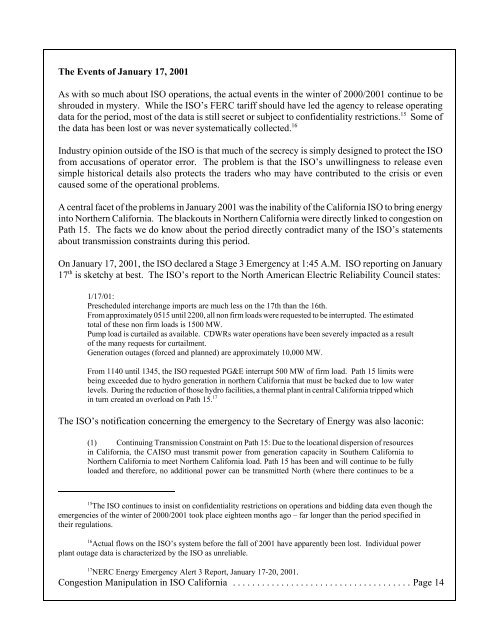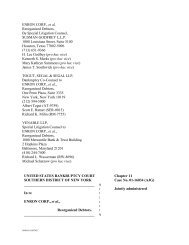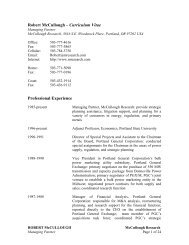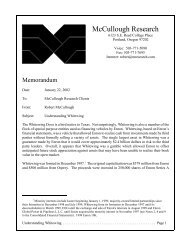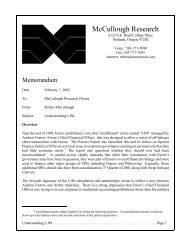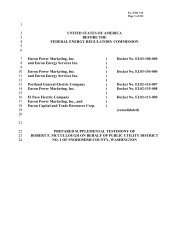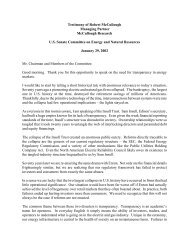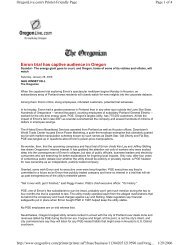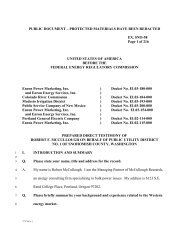Congestion Manipulation - McCullough Research
Congestion Manipulation - McCullough Research
Congestion Manipulation - McCullough Research
Create successful ePaper yourself
Turn your PDF publications into a flip-book with our unique Google optimized e-Paper software.
The Events of January 17, 2001<br />
As with so much about ISO operations, the actual events in the winter of 2000/2001 continue to be<br />
shrouded in mystery. While the ISO’s FERC tariff should have led the agency to release operating<br />
data for the period, most of the data is still secret or subject to confidentiality restrictions. 15 Some of<br />
the data has been lost or was never systematically collected. 16<br />
Industry opinion outside of the ISO is that much of the secrecy is simply designed to protect the ISO<br />
from accusations of operator error. The problem is that the ISO’s unwillingness to release even<br />
simple historical details also protects the traders who may have contributed to the crisis or even<br />
caused some of the operational problems.<br />
A central facet of the problems in January 2001 was the inability of the California ISO to bring energy<br />
into Northern California. The blackouts in Northern California were directly linked to congestion on<br />
Path 15. The facts we do know about the period directly contradict many of the ISO’s statements<br />
about transmission constraints during this period.<br />
On January 17, 2001, the ISO declared a Stage 3 Emergency at 1:45 A.M. ISO reporting on January<br />
17 th is sketchy at best. The ISO’s report to the North American Electric Reliability Council states:<br />
1/17/01:<br />
Prescheduled interchange imports are much less on the 17th than the 16th.<br />
From approximately 0515 until 2200, all non firm loads were requested to be interrupted. The estimated<br />
total of these non firm loads is 1500 MW.<br />
Pump load is curtailed as available. CDWRs water operations have been severely impacted as a result<br />
of the many requests for curtailment.<br />
Generation outages (forced and planned) are approximately 10,000 MW.<br />
From 1140 until 1345, the ISO requested PG&E interrupt 500 MW of firm load. Path 15 limits were<br />
being exceeded due to hydro generation in northern California that must be backed due to low water<br />
levels. During the reduction of those hydro facilities, a thermal plant in central California tripped which<br />
in turn created an overload on Path 15. 17<br />
The ISO’s notification concerning the emergency to the Secretary of Energy was also laconic:<br />
(1) Continuing Transmission Constraint on Path 15: Due to the locational dispersion of resources<br />
in California, the CAISO must transmit power from generation capacity in Southern California to<br />
Northern California to meet Northern California load. Path 15 has been and will continue to be fully<br />
loaded and therefore, no additional power can be transmitted North (where there continues to be a<br />
15<br />
The ISO continues to insist on confidentiality restrictions on operations and bidding data even though the<br />
emergencies of the winter of 2000/2001 took place eighteen months ago – far longer than the period specified in<br />
their regulations.<br />
16<br />
Actual flows on the ISO’s system before the fall of 2001 have apparently been lost. Individual power<br />
plant outage data is characterized by the ISO as unreliable.<br />
17<br />
NERC Energy Emergency Alert 3 Report, January 17-20, 2001.<br />
<strong>Congestion</strong> <strong>Manipulation</strong> in ISO California .....................................Page 14


